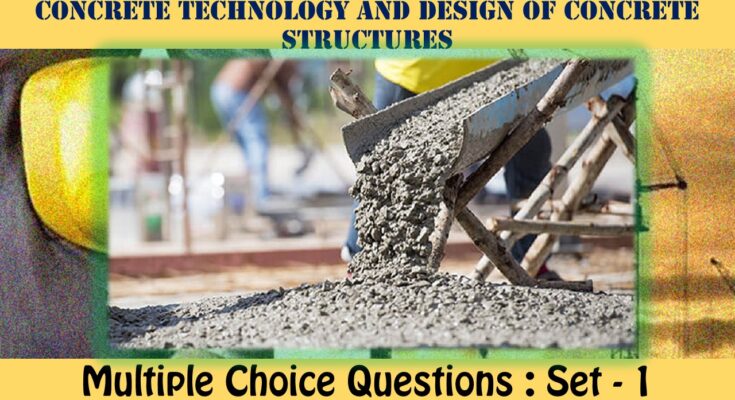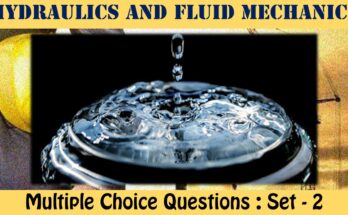MCQ Questions Civil Engineering Concrete Technology and Design of Concrete Structures
The interviewer is almost as nervous as the candidate in most interviews. You might wonder if you look confident enough, if you will hire the right person, or if you are asking the right engineering interview questions. The last question is arguably the most crucial part to worry about when you’re interviewing candidates. Other topics on Civil Engineering Multiple Choice Questions can be accessed
MCQ Questions Civil Engineering Concrete Technology and Design of Concrete Structures - Set - 1
Question 1:
The approximate value of the ratio between direct tensile strength and flexural strength is
a) 0.33
b) 0.5
c) 0.75
d) 1.0
Correct Answer – (B)
Question 2 :
Air entrainment in the concrete increases
a) workability
b) strength
c) the effects of temperature variations
d) the unit weight
Correct Answer – (A)
Question 3 :
Workability of concrete is inversely pro¬portional to
a) time of transit
b) ‘vater-cement ratio
c) the air in the mix
d) size of aggregate
Correct Answer – (A)
Question 4 :
The property of the ingredients to separate from each other while placing the concrete is called
a) segregation
b) compaction
c) shrinkage
d) bulking
Correct Answer – (A)
Question 5 :
The property of fresh concrete, in which the water in the mix tends to rise to the surface while placing and compacting, is called
a) segregation
b) bleeding
c) bulking
d) creep
Correct Answer – (B)
MCQ Questions Civil Engineering Concrete Technology and Design of Concrete Structures
Question 6:
The relation between modulus of rupture fcr, splitting strength fcs and direct tensile strength fcl is given by
a) tcr – rcs = tct
b) fcr>fcs>fc.
C) fcr<fcs<fc>
d) fc5>fcr>fc.
Correct Answer – (B)
Question 7:
Approximate value of shrinkage strain in concrete, is
a) 0.003
b) 0.0003
c) 0.00003
d) 0.03
Correct Answer – (B)
Question 8:
Workability of concrete is directly proportional to
a) aggregate cement ratio
b) time of transit
c) grading of the aggregate
d) all of above
Correct Answer – (C)
Question 9:
Select the incorrect statement
a) Lean mixes bleed more as compared to rich ones.
b) Bleeding can be minimized by adding pozzuolana finer aggregate.
c) Bleeding can be increased by addition ‘of calcium chloride.
d) none of the above
Correct Answer – (D)
Question 10:
To determine the modulus of rupture, the size of test specimen used is
a) 150 x150 x500 mm
b) 100 x100 x700 mm
c) 150 x150 x700 mm
d) 100 x100 x500 mm
Correct Answer – (C)
- NCERT Solutions Class 12 Mathematics RD Sharma Sets : Exercise 1.1
- NCERT Solutions Class 12 Mathematics RD Sharma Sets : Exercise 1.2
- NCERT Solutions Class 12 Mathematics RD Sharma Sets : Exercise 1.3
- NCERT Solutions Class 12 Mathematics RD Sharma Sets : Exercise 1.4
- NCERT Solutions Class 12 Mathematics RD Sharma Trigonometric Functions : Exercise – 5.1
- NCERT Solutions Class 12 Mathematics RD Sharma Trigonometric Functions : Exercise – 5.2
- NCERT Solutions Class 12 Mathematics RD Sharma Trigonometric Functions : Exercise – 5.3
- NCERT Solutions Class 12 Mathematics RD Sharma Quadratic Equations : Exercise – 14.1
- NCERT Solutions Class 12 Mathematics RD Sharma Quadratic Equations : Exercise – 14.2
- NCERT Solutions Class 12 Mathematics RD Sharma Linear Inequations : Exercise – 15.1
- NCERT Solutions Class 12 Mathematics RD Sharma Linear Inequations : Exercise – 15.2
- NCERT Solutions Class 12 Mathematics RD Sharma Linear Inequations : Exercise – 15.3
- NCERT Solutions Class 12 Mathematics RD Sharma Linear Inequations : Exercise – 15.4
- NCERT Solutions Class 12 Mathematics RD Sharma Linear Inequations : Exercise – 15.5
- NCERT Solutions Class 12 Mathematics RD Sharma Linear Inequations : Exercise – 15.6
Multiple Choice Questions for Competitive Exams
- Multiple Choice Questions Class 12 Chemistry The Solid State
Set -1 Set -2 Set -3 Set -4 Set -5 - MCQ Questions Class 12 Solutions With Answers
Set -1 Set -2 Set -3 Set -4 Set -5 - MCQ Questions Class 12 Electrochemistry With Answers
Set -1 Set -2 Set -3 Set -4 Set -5 - MCQ Questions Class 12 Chemical Kinetics With Answers
Set -1 Set -2 Set -3 Set -4 Set -5 - MCQ Questions Class 12 Surface Chemistry With Answers
Set -1 Set -2 Set -3 Set -4 Set -5 - MCQ Questions Class 12 General Principles and Processes of Isolation of Elements With Answers
Set -1 Set -2 Set -3 Set -4 Set -5




